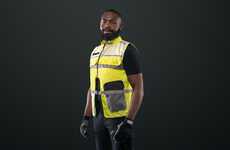
The Anxiety Suit Analzyes the Risk-Taking Behaviour in Humans
Meghan Young — July 21, 2011 — Lifestyle
References: dan-watson & designbuzz
Although there have been many psychology experiments that have explored the idea of risk and risk-taking behavior in humans, the Anxiety Suit takes it to the streets by allowing designer Dan Watson to explore how manipulating behavior will affect a person's perception of the magnitude of a particular risk.
Inspired by his study of street crimes, Watson built the Anxiety Suit, which followed a four-phase experiment. The first step involved identifying those who assess risk poorly and to see if they would change their behavior when aware of the risk. The second step explored different ways of communicating information to a human. The third step focused on altering the person's emotional state and the final step combined all of these using the Anxiety Suit.
The Anxiety Suit showed that humans rank low on the risk-assessing graph and do modify behavior when they are aware of the magnitude of the risk.
Inspired by his study of street crimes, Watson built the Anxiety Suit, which followed a four-phase experiment. The first step involved identifying those who assess risk poorly and to see if they would change their behavior when aware of the risk. The second step explored different ways of communicating information to a human. The third step focused on altering the person's emotional state and the final step combined all of these using the Anxiety Suit.
The Anxiety Suit showed that humans rank low on the risk-assessing graph and do modify behavior when they are aware of the magnitude of the risk.
Trend Themes
1. Risk-taking Behavior - Opportunity to develop products and services that manipulate behavior and perception of risk in humans.
2. Behavioral Modification - Creating tools and techniques to change human behavior and decision-making based on awareness of risk.
3. Emotional Manipulation - Exploring ways to alter human emotional states to influence risk perception.
Industry Implications
1. Fashion - Incorporating risk-responsive features into clothing design to enhance personal safety and risk management.
2. Technology - Developing wearable tech and communication devices to provide real-time risk information to individuals.
3. Psychology - Applying insights from risk-related experiments to create behavior change interventions and therapy techniques.
0.8
Score
Popularity
Activity
Freshness























